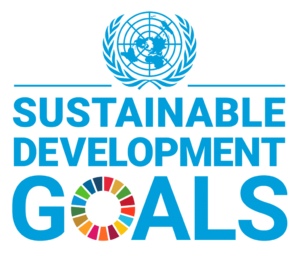
The Sustainable Development Goals (SDGs) refers to the successor goal set following the Millennium Development Goals (MDGs). The goals were finalised and presented in September 2015 (25-27 September) in New York, USA.[1] The official term for the whole agenda is Transforming our world: the 2030 Agenda for Sustainable Development.[1]
The SDGs have addressed numerous criticisms that were levelled at the MDGs, principally a concern that while the MDGs' targets were largely "achieved", they focused on the symptoms, and they had failed to account for equity and environmental sustainability.[2] Moreover, uneven progress in achieving the MDGs occurred due to the use of global indicators.[2]
By contrast, the SDGs are meant to focus on the symptoms and their development was formed through much more transparent processes than experienced with the MDGs.[2]The SDGs were a result of the largest consultation process undertaken in United Nations history.[2]
The goals and targets[edit | edit source]
The SDGs consist of 17 goals and 169 targets. The 17 goals are as follows:[1]
- Poverty - End poverty in all its forms everywhere[3]
- Food - End hunger, achieve food security and improved nutrition and promote sustainable agriculture[4]
- Health - Ensure healthy lives and promote well-being for all at all ages[5]
- Education - Ensure inclusive and equitable quality education and promote lifelong learning opportunities for all[6]
- Women - Achieve gender equality and empower all women and girls[7]
- Water - Ensure availability and sustainable management of water and sanitation for all[8]
- Energy - Ensure access to affordable, reliable, sustainable and modern energy for all[9]
- Economy - Promote sustained, inclusive and sustainable economic growth, full and productive employment and decent work for all[10]
- Infrastructure - Build resilient infrastructure, promote inclusive and sustainable industrialization and foster innovation[11]
- Inequality - Reduce inequality within and among countries[12]
- Habitation - Make cities and human settlements inclusive, safe, resilient and sustainable[13]
- Consumption - Ensure sustainable consumption and production patterns[14]
- Climate - Take urgent action to combat climate change and its impacts[15]
- Marine-ecosystems - Conserve and sustainably use the oceans, seas and marine resources for sustainable development[16]
- Ecosystems - Protect, restore and promote sustainable use of terrestrial ecosystems, sustainably manage forests, combat desertification, and halt and reverse land degradation and halt biodiversity loss[17]
- Institutions - Promote peaceful and inclusive societies for sustainable development, provide access to justice for all and build effective, accountable and inclusive institutions at all levels[18]
- Sustainability - Strengthen the means of implementation and revitalize the global partnership for sustainable development[19]
Projects on Appropedia[edit | edit source]
Click on any item in the gallery to explore projects on Appropedia for each SDG:
Criticism[edit | edit source]
Transparency has been questioned by some, as the usual last minute changes took place without consultation and have impacted the extent and focus of some of the goals.[2]The main problem, as noted by Henfrey and Penha-Lopes, is that the SDGs continue to be framed within the assumption that economic growth, with its typical presumption that it is the only paradigm through which human society can thrive.[2]Leaving this assumption unchallenged will ironically cause many of the causes to go unaddressed and may increase social and ecological harms. Nevertheless, where individuals, community groups and organizations take the SDGs and make use of them to address the causes, this is a hopeful way ahead for people in partnership with the planet and one another.
News and comment[edit | edit source]
 UN sustainable development goals failing to have meaningful impact, our research warns, The Conversation (Jun 20, 2022)
UN sustainable development goals failing to have meaningful impact, our research warns, The Conversation (Jun 20, 2022)
Sources and citations[edit | edit source]
- ↑ 1.0 1.1 1.2 https://en.wikipedia.org/wiki/Sustainable_Development_Goals
- ↑ 2.0 2.1 2.2 2.3 2.4 2.5 Henfrey and Penha-Lopes, Permaculture and climate change adaptation
- ↑ "Goal 1: No poverty". Retrieved 28 September 2015.
- ↑ "Goal 2: Zero hunger". Retrieved 28 September 2015.
- ↑ "Goal 3: Good health and well-being". Retrieved 28 September 2015.
- ↑ "Goal 4: Quality education". Retrieved 28 September 2015.
- ↑ "Goal 5: Gender equality". Retrieved 28 September 2015.
- ↑ "Goal 6: Clean water and sanitation". Retrieved 28 September 2015.
- ↑ "Goal 7: Affordable and clean energy". Retrieved 28 September 2015.
- ↑ "Goal 8: Decent work and economic growth". Retrieved 28 September 2015.
- ↑ "Goal 9: Industry, innovation, infrastructure". Retrieved 28 September 2015.
- ↑ "Goal 10: Reduced inequalities". Retrieved 28 September 2015.
- ↑ "Goal 11: Sustainable cities and communities". Retrieved 28 September 2015.
- ↑ "Goal 12: Responsible consumption, production". Retrieved 28 September 2015.
- ↑ "Goal 13: Climate action". Retrieved 28 September 2015.
- ↑ "Goal 14: Life below water". Retrieved 28 September 2015.
- ↑ "Goal 15: Life on land". Retrieved 28 September 2015.
- ↑ "Goal 16: Peace, justice and strong institutions". Retrieved 28 September 2015.
- ↑ "Goal 17: Partnerships for the goals". Retrieved 28 September 2015.
Book sources[edit | edit source]
- Thomas Henfrey and Gil Pehna-Lopes. (2015) Permaculture and climate change adaptation. ISBN 978-1-85623-275-3
















